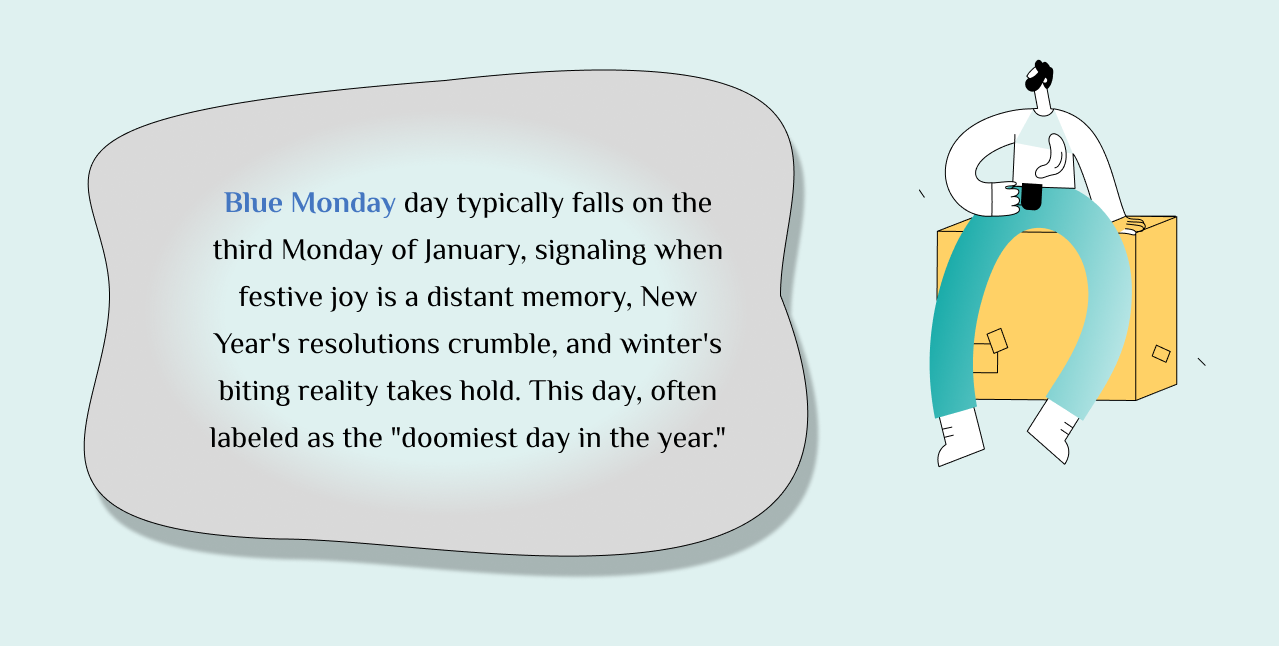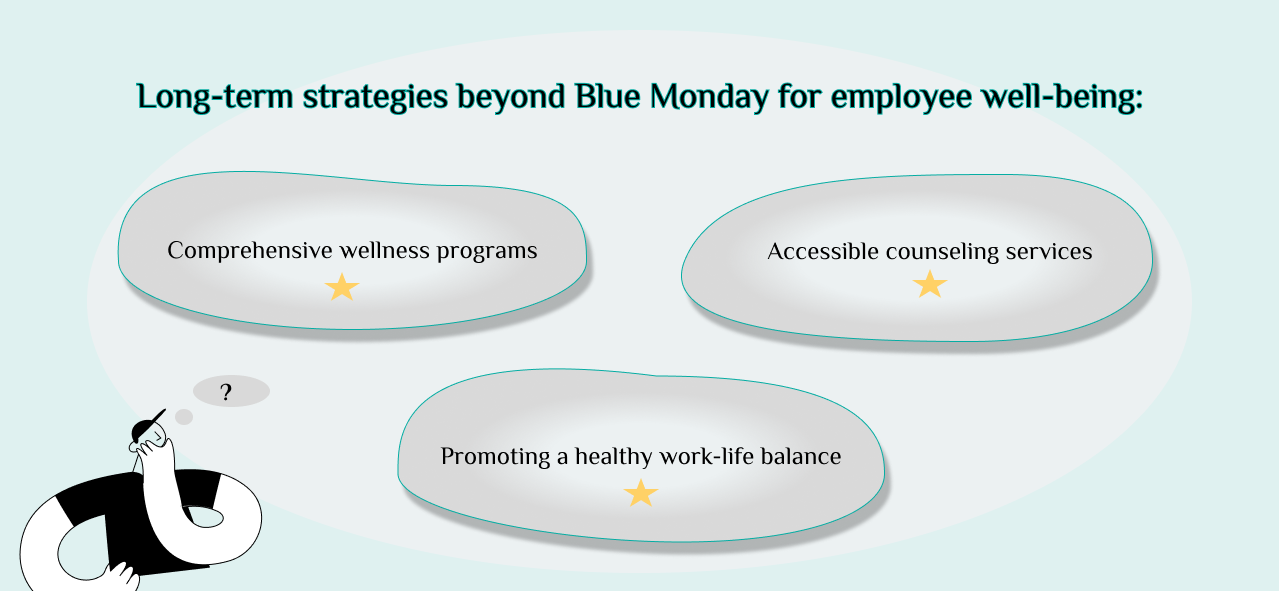On a cold January morning, as the holiday joy fades, a day on the calendar brings a shadow to our collective mood – Blue Monday. As a nursing student, single mom, and a seeker of human connection, preparing for the supposedly gloomiest day of the year, I find myself compelled to explore the depths of its significance. And even more importantly, to unravel strategies that could transform it into a day of resilience, positivity, and employee well-being. This article is about combating the collective melancholy associated with Blue Monday and weaving a narrative of hope, understanding, and proactive measures.
So, What Is The Significance Of Blue Monday 2024?
When is Blue Monday? A red date on my calendar caught my eye – January 23, 2024. It’s Blue Monday 2024. But why does this day have such a reputation for being the “most depressing day of the year?”
Blue Monday day typically falls on the third Monday of January, signaling when festive joy is a distant memory, New Year’s resolutions crumble, and winter’s biting reality takes hold. This day, often labeled as the “doomiest day in the year,” isn’t just a random designation. It’s based on pseudo-scientific calculations that factor in weather conditions, post-holiday financial strain, the time elapsed since Christmas, and the duration since the inevitable faltering of New Year’s resolutions.
According to various studies, January is a peak period for low moods and heightened feelings of sadness and stress. Factors like reduced daylight, post-holiday financial strain, and the pressure of New Year’s resolutions contribute to a collective dip in mood during this time. Combining these factors gives Blue Monday its distinctive reputation as a day when people often feel the weight of the winter blues more intensely. Now you know what day is Blue Monday!
Five Creative Events To Uplift Employees
As a nursing student and single mom, navigating life has taught me the importance of safeguarding mental health. Working in the retail sector, I’ve witnessed firsthand the toll the winter blues can take on my colleagues. Yet, in my quest to combat the melancholy of Blue Monday, I’ve stumbled upon creative events that uplift employees and infuse the workplace with renewed morale:
- Wellness workshops. Consider organizing wellness workshops that focus on holistic health. These can include yoga sessions, mindfulness meditation classes, or even brief fitness challenges. Physical well-being is closely intertwined with mental health, and offering these workshops provides a break and encourages a healthy lifestyle among employees.
- Random acts of kindness day. Designate a day where the workplace becomes a canvas for kindness. Encourage employees to perform random acts of kindness for their colleagues. It could be as simple as leaving an uplifting note on someone’s desk or organizing a surprise coffee break. Acts of kindness not only create a positive atmosphere but also foster a sense of community within the workplace.
- Inspirational speaker series. Invite a motivational speaker or an industry expert to address the team. These speakers can share their experiences, insights, and tips for navigating challenges. The power of storytelling and shared wisdom can be potent in lifting spirits and providing a fresh perspective on work and life.
- DIY craft day. Tap into your team’s creativity with a do-it-yourself (DIY) craft day. Set up stations with various crafting materials, allowing employees to unleash their artistic side. Engaging in creative activities has proven benefits for mental well-being, and the collaborative nature of a DIY craft day can strengthen the bonds among team members.
- Virtual travel experience. In a world where travel might not always be possible, bring the world to your workplace with a virtual travel experience. Use technology to explore different cultures, cuisines, and traditions. It adds an element of excitement and broadens perspectives, fostering a sense of connection to the global community.
The Role Of Breaks And Healthy Eating For Employees
Recognizing the importance of breaks and maintaining health and diet is fundamental to promoting employee well-being. As a nursing student, I’ve learned that self-care is applicable in my personal life and equally vital in the workplace. Encouraging employees to take regular breaks can impact their overall well-being, and simple activities like a short walk, stretching exercises, or a brief meditation session can bring significant benefits.
The impact of breaks on well-being
Prioritizing breaks in workplace culture goes beyond conventional thinking about productivity. It recognizes the direct correlation between taking breaks and overall well-being. Employers can encourage employees to step away from their workstations for short intervals throughout the day as a proactive strategy. It can be particularly effective in preventing burnout and enhancing focus.
Simple activities during breaks, such as a brief walk, stretching exercises, or a quick meditation session, can act as powerful tools to alleviate stress and boost happiness. Employers can provide designated break areas or even organize group activities to make these moments of respite more accessible and enjoyable for their team.
The significance of a well-balanced diet
Paying attention to dietary habits is another important element in the well-being equation. A well-balanced diet isn’t merely about physical health. It also directly influences mental well-being. Employers can contribute to this by fostering a food environment that promotes nutritious choices.
Easy access to nutritious snacks in the workplace supports healthy eating habits. Alternatives to traditional snacks, such as fresh fruits, nuts, or yogurt, can invigorate energy levels and mood. Besides, employers can take initiative by organizing healthy cooking workshops, allowing their employees to get in touch with the principles of balanced nutrition.
Try It: Recognizing And Rewarding Good Work
Recognition is a powerful tool in boosting workplace morale. During my journey from Delaware to Philadelphia, I realized the importance of acknowledging and rewarding good work. Blue Monday can be transformed into an opportunity to appreciate employees’ efforts and recognize their contributions.
Implementing an employee recognition program can be as simple as a monthly “star employee” award or a shout-out during team events. This serves to boost individual morale and sets a positive tone for the workplace.
Long-term strategies beyond Blue Monday for ongoing employee well-being
Moving beyond events and short-term measures, it becomes vital for employers to prioritize the long-term mental and physical health of their workforce. I understand how important the continual investment in mental well-being is parallel to physical health.
Comprehensive wellness programs
Employers can carve a path toward sustainable employee well-being with comprehensive wellness programs. These programs should extend beyond sporadic events and encompass ongoing initiatives that address various dimensions of health. Physical fitness challenges, mental health workshops, and nutritional education can be integral to a holistic wellness program.
Accessible counseling services
Recognizing the complex nature of mental health, employers should consider offering accessible counseling services as part of their long-term strategy. Establishing partnerships with mental health professionals or providing access to confidential counseling services can be instrumental. It gives employees continuous support when dealing with work or personal life challenges.
Promoting a healthy work-life balance
A healthy work-life balance is the cornerstone of long-term well-being. Employers should foster a culture that values and supports personal time. Encouraging reasonable working hours, discouraging excessive overtime, and promoting the use of vacation days are practical steps toward creating an environment where employees can thrive professionally and personally.
Monitoring employee well-being: A caring approach
Keeping a watchful eye on employee well-being requires a caring touch, especially when addressing the prevalence of low moods. As a nursing student and a mom, I believe in a thoughtful, holistic approach at the workplace.
Regular check-ins and simple surveys can be powerful tools for addressing low moods. These give employees a chance to share how they feel without any pressure. Look out for changes like increased absenteeism, lower energy, or less enthusiasm about work – these can be signs of continuous low moods.
Creating a workplace where talking about mental health is normal is crucial. Offering counseling services or workshops can be a gentle way to support employees. Training managers to notice these signs and have caring conversations is helpful. Recognizing this problem helps individual team members and builds a workplace that cares for everyone’s well-being. It’s about creating a space where people feel heard, understood, and supported in their journey to feeling better.
Some innovative perks and benefits
Innovative perks and benefits go beyond the usual to make work happier. Simple things like flexible schedules, remote work options, or extra vacation days can make a big difference. Companies offering mental health days or gym memberships show they care about well-being. Some even provide learning allowances for personal growth. These innovative perks attract talent and create a workplace where employees feel valued. It’s about going the extra mile to say, “Your long-term happiness matters, and we’re here to make your work life better.”
FAQ
- What is Blue Monday, and why is it significant?
Blue Monday is a term that represents the third Monday of January, believed to be the most depressing day of the year. It is commonly associated with post-holiday blues, winter weather, and failed New Year’s resolutions, contributing to a collective sense of gloom.
- How can organizations uplift employees on Blue Monday?
Organizations can uplift employees on Blue Monday by organizing creative events, encouraging breaks and healthy eating, recognizing and rewarding good work, and implementing long-term strategies for employee well-being. These initiatives help boost workplace morale and foster a positive work culture.
- What are the long-term strategies for maintaining employee morale?
Long-term strategies for maintaining employee morale include monitoring well-being, fostering a culture of support, implementing innovative perks and benefits, and investing in mental health through wellness programs and counseling services.






